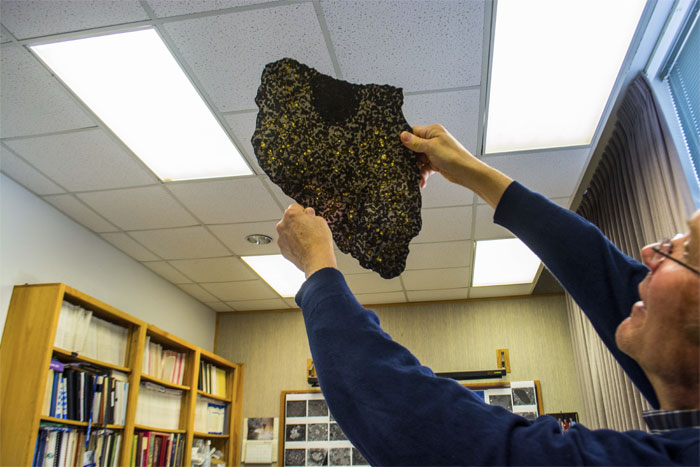.

Carl Agee holds up a meteorite from the collection at Northrop Hall. Agee is currently working on updating the Meteorite Museum for an April opening.
.
In 2011, Carl Agee received a rock in the mail from a meteorite collector in Morocco. At the time, nobody knew what it was or where it had come from. Even for Agee, director of UNM’s Institute for Meteoritics, the rock’s origin remained a mystery for quite some time.
“This collector sent it to me because no one knew what it was, and it took me months of laboratory analyses to figure it out,” Agee said.
At the Department of Earth and Planetary Sciences, he tested the rock’s chemical composition, isotopic composition, and mineralogy to determine its makeup.
“From all of those different lines of evidence, the picture that emerged was that it was a meteorite from Mars,” he said.
Now, Agee is being funded by NASA to study the meteorite, known as NWA 7034, or “Black Beauty” for its dark color.
There are several reasons why NASA is interested in Black Beauty. Tests showed that it contains 10 to 30 times more water than any previously studied Martian sample. Agee and his team also found that the meteorite is composed of a variety of minerals, ranging from 4.4 to 2.1 billion years old.
“There are different fragments of the Martian crust all together in the same meteorite in addition to the water, so there’s a record of the surface processes on Mars for about two billion years,” Agee said.
Black Beauty is also notable, Agee said, because it is very similar to the rock samples that are currently being collected by the two rovers on Mars, which use a robotic remote sensing technique to identify the rocks’ composition.
“Black Beauty finally forms the first tangible meteorite link to the rocks that NASA’s rovers are sampling in outcrops on Mars,” Agee wrote in the Universities Space Research Association’s report for the Eighth International Conference on Mars. He notes that the meteorite provides insight into volcanic activity on the planet, which is one of his research specialties.
While Agee is best known for his work in meteoritics, he was originally trained as a geologist, which is how he began researching volcanoes. He said he became interested in planetary geology while working on his doctoral degree at Columbia University.
“If you’re trained in geology, planets are like whole new worlds to map out and understand,” Agee said.
After finishing at Columbia, he taught at Harvard for eight years before moving to Houston to work at NASA’s Johnson Space Center. He said he came to UNM because he enjoys the intellectual atmosphere of a university.
“I have contracts for NASA that I work on, so I’m still involved with them,” Agee said. “In addition to Black Beauty, they have also funded me for years to study the processes of planetary volcanism.”
He uses the department’s high-pressure laboratory to simulate the conditions of planetary interiors to study the behavior of magma, he said.
In addition to this research, he investigates various samples sent to him by meteorite hunters and dealers. Most of these samples come from Northern Africa — Morocco in particular, which Agee said is the focus of the meteorite trade due to its laws that allow them to be bought and sold. He said that most rocks found in the Sahara desert suspected of being meteorites end up there, where they are sent out to collectors and scientists in Europe and the United States.
“I get Facebook messages from nomads in the Sahara sending me pictures of rocks they’ve found,” he said. “Or I’ll get a FedEx from Morocco. Just like with Black Beauty, I get these exciting, mysterious, unknown meteorites sent to me.”
Sometimes testing reveals these samples to be terrestrial rocks, or as Agee calls them, “meteo-wrongs.”
“On the other hand, some of them turn out to be a totally new type that’s never been seen before,” he said. “That sort of detective work really interests me.”
He said he currently has a pending proposal to study yet another previously unknown Martian meteorite for NASA.
Currently, Agee is also working on updating the Meteorite Museum in Northrop Hall, which has not had a major renovation in about four decades. He said the department plans to re-open the museum in April.
“I always have something in the works,” he said.
Quelle: New Mexico Daily Lobo
4308 Views
